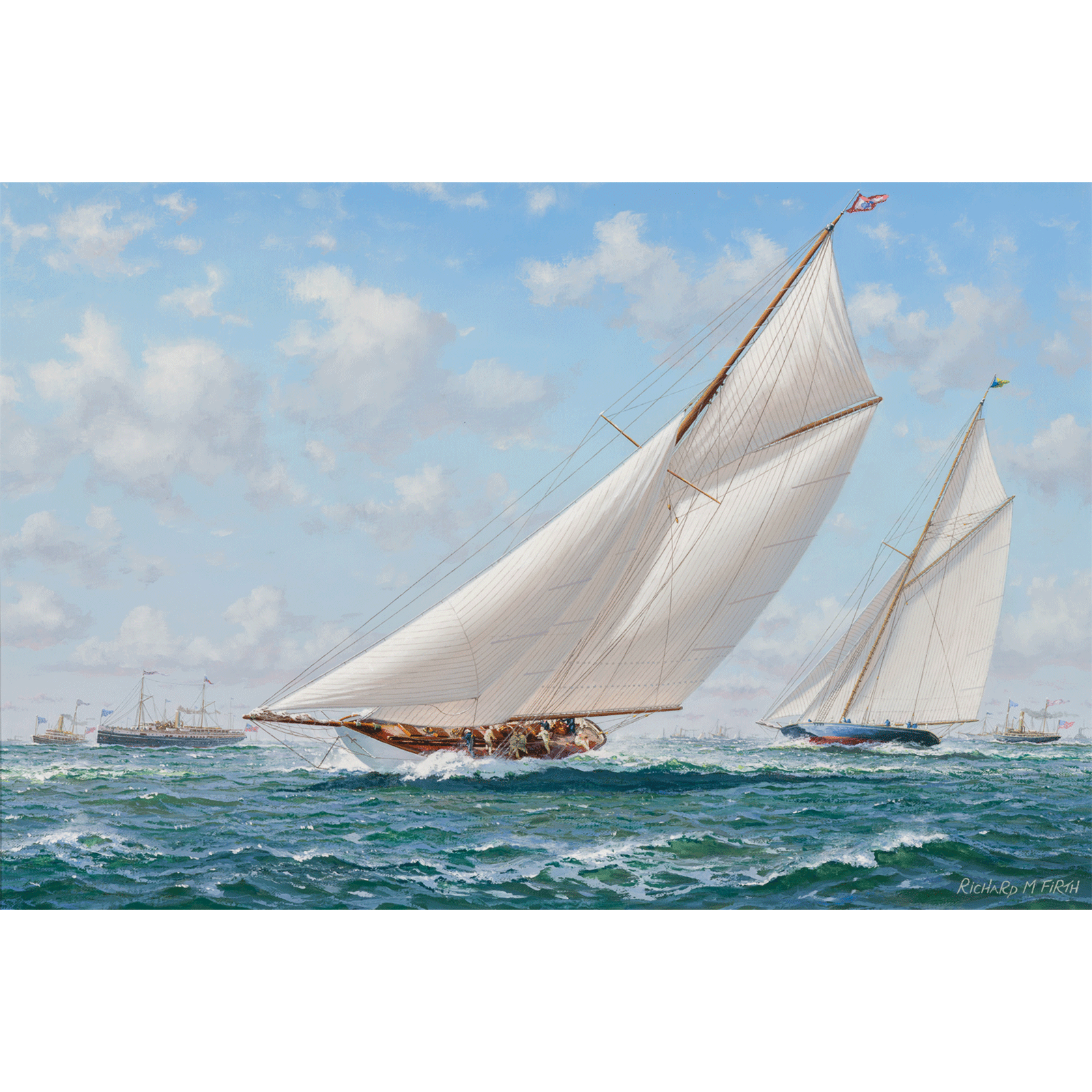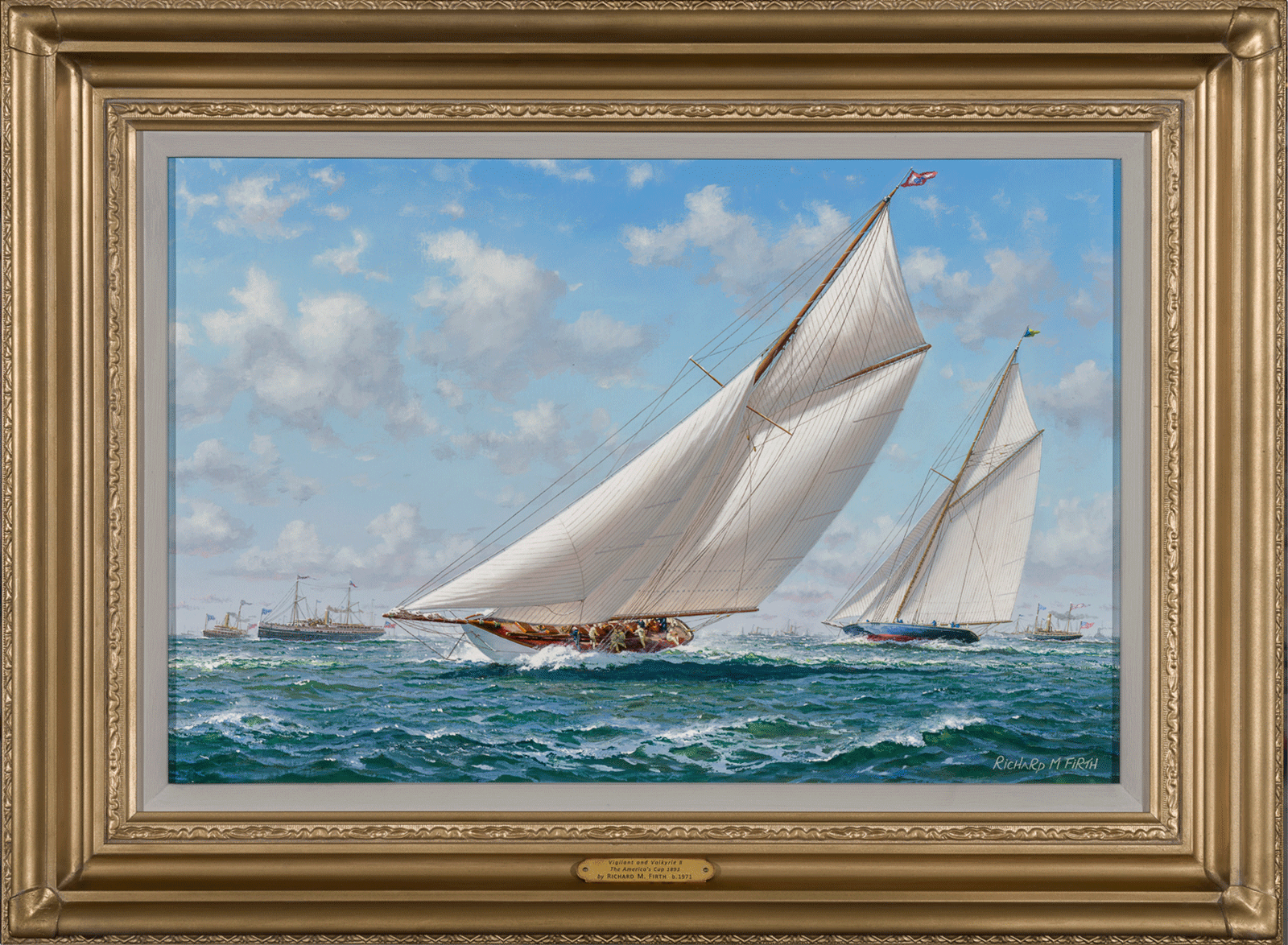2020 Fine Sporting Art, American Paintings, and Sculpture
164| Richard M. Firth (British, b. 1971)
Vigilant And Valkyrie II, The America Cup 1893
$10,350.00
In the spring of 1889, the Earl of Dunraven?s challenge was accepted by the New York Yacht Club, rules were revised, and a date for the America?s Cup was set for the fall of 1893. Both parties soon set about designing vessels that adapted to the new allowances. The Earl of Dunraven comissioned George L. Watson of Glasgow to design Valkyrie II, and the yachtsmen of New York and Boston chose Nathanael Green Herreshoff of the New York Syndicate as their champion and skipper of Vigilant.
Providing a sharp beginning, gunfire signaled the start of the race. The first race left both vessels underutilized due to lack of wind, but the second was blessed by a freshening wind. Vigilant emerged victorious from both races. The third challenge was declared void due to lack of wind. The date of the final, decisive race was set for Friday, Oct. 13.
The final race would be the most challenging and, as the date ordained, was fated to meet with bad luck. A high wind blowing in from the east produced a turbulent sea, and it wasn?t long before Valkyrie II sustained damage to her pulley block. Unaware of the damage to the rival ship, Vigilant followed her around the final mark. Even though Valkyrie had undertaken considerable damage, she was still two minutes ahead when further calamity struck. While being hoisted, Valkyrie?s spinnaker split down the middle. Vigilant seized the advantage, winning the America?s Cup by 40 seconds. The event became the most memorable race of the decade.
Oil on canvas, 14" x 21"
$12000. - $18000.
In the spring of 1889, the Earl of Dunraven?s challenge was accepted by the New York Yacht Club, rules were revised, and a date for the America?s Cup was set for the fall of 1893. Both parties soon set about designing vessels that adapted to the new allowances. The Earl of Dunraven comissioned George L. Watson of Glasgow to design Valkyrie II, and the yachtsmen of New York and Boston chose Nathanael Green Herreshoff of the New York Syndicate as their champion and skipper of Vigilant. Providing a sharp beginning, gunfire signaled the start of the race. The first race left both vessels underutilized due to lack of wind, but the second was blessed by a freshening wind. Vigilant emerged victorious from both races. The third challenge was declared void due to lack of wind. The date of the final, decisive race was set for Friday, Oct. 13. The final race would be the most challenging and, as the date ordained, was fated to meet with bad luck. A high wind blowing in from the east produced a turbulent sea, and it wasn?t long before Valkyrie II sustained damage to her pulley block. Unaware of the damage to the rival ship, Vigilant followed her around the final mark. Even though Valkyrie had undertaken considerable damage, she was still two minutes ahead when further calamity struck. While being hoisted, Valkyrie?s spinnaker split down the middle. Vigilant seized the advantage, winning the America?s Cup by 40 seconds. The event became the most memorable race of the decade.
In the spring of 1889, the Earl of Dunraven?s challenge was accepted by the New York Yacht Club, rules were revised, and a date for the America?s Cup was set for the fall of 1893. Both parties soon set about designing vessels that adapted to the new allowances. The Earl of Dunraven comissioned George L. Watson of Glasgow to design Valkyrie II, and the yachtsmen of New York and Boston chose Nathanael Green Herreshoff of the New York Syndicate as their champion and skipper of Vigilant. Providing a sharp beginning, gunfire signaled the start of the race. The first race left both vessels underutilized due to lack of wind, but the second was blessed by a freshening wind. Vigilant emerged victorious from both races. The third challenge was declared void due to lack of wind. The date of the final, decisive race was set for Friday, Oct. 13. The final race would be the most challenging and, as the date ordained, was fated to meet with bad luck. A high wind blowing in from the east produced a turbulent sea, and it wasn?t long before Valkyrie II sustained damage to her pulley block. Unaware of the damage to the rival ship, Vigilant followed her around the final mark. Even though Valkyrie had undertaken considerable damage, she was still two minutes ahead when further calamity struck. While being hoisted, Valkyrie?s spinnaker split down the middle. Vigilant seized the advantage, winning the America?s Cup by 40 seconds. The event became the most memorable race of the decade.
To Leave An Absentee Bid, Please Enter An Amount Below



